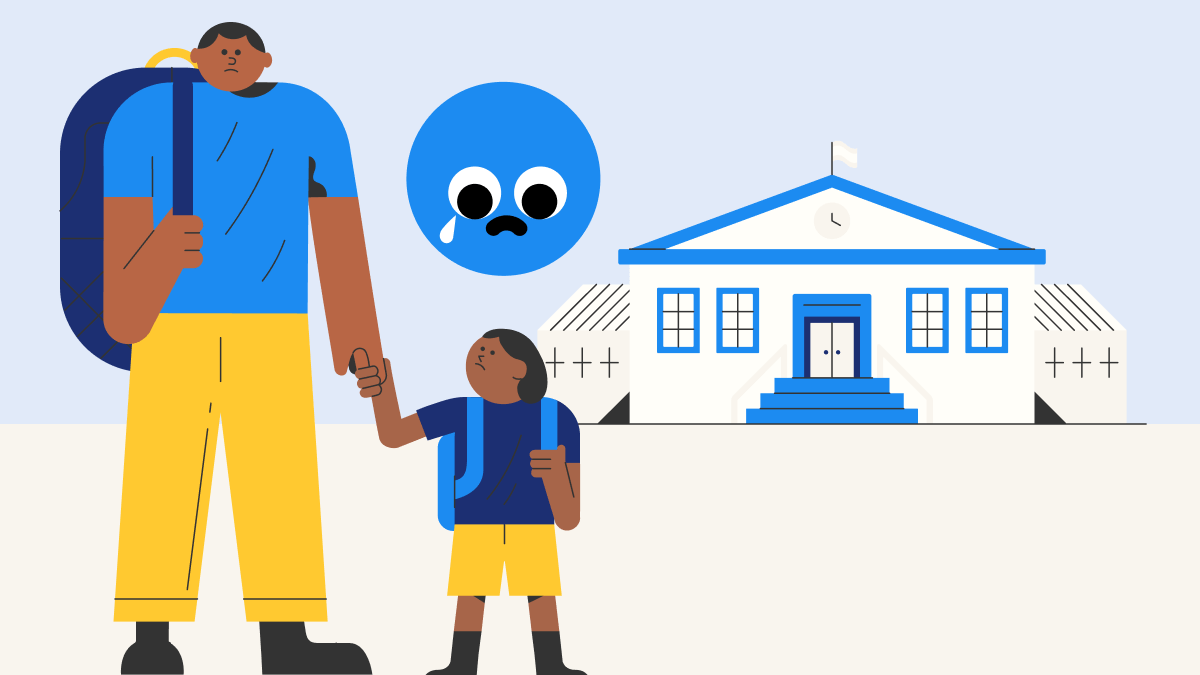If you’re a parent of a child who struggles with goodbyes, you’re not alone.
When children experience separation anxiety, their parents often feel anxiety and guilt during routines like school drop-offs. In those moments, it helps to remember that a fear of separation is a normal part of development for many young children.
However, if a child’s fear becomes intense and persistent, and starts to affect their ability to attend school or participate in daily activities, it may be more than just a phase. In such cases, it’s important to be aware of the signs of Separation Anxiety Disorder.
What is separation anxiety?
According to the Diagnostic Statistical Manual, Fifth Edition (DSM-5), a handbook professionals use to diagnose mental health conditions, Separation Anxiety Disorder in children is characterised by an excessive fear or anxiety about being apart from their attachment figure, who is typically their caregiver.
Now, it’s completely natural for children aged 6 months to 3 years to show signs of separation anxiety. In fact, a little bit of separation anxiety could even mean that your child is developing strong emotional bonds and a sense of security while learning to explore the world.
While this naturally resolves with time and gentle support, intense distress sometimes continues well beyond toddlerhood or worsens with age. When that happens, it could be time to seek professional advice.
What causes separation anxiety?
There isn’t a single cause of separation anxiety, but several risk factors may contribute:
- Family History: If anxiety disorders run in the family, children may inherit both genetic vulnerabilities and patterns of anxious behaviour.
- Temperament: Even without a family history of anxiety, some children may naturally be more sensitive or cautious, making them more prone to anxiety.
- Life changes or stressful events: Family events such as parental separation or the arrival of a new sibling can trigger separation anxiety. Other transitions, like starting pre-school, can also heighten anxiety.
- Parental responses: As children look to caregivers for cues about how to respond to situations, well-meaning actions like offering extra reassurance or staying longer during goodbyes may unintentionally signal to a child that separation is something to be feared.
Symptoms of separation anxiety
The DSM-5 outlines the following symptoms of separation anxiety:
- Excessive distress when anticipating or experiencing separation from home or caregivers (e.g., crying, tantrums, panic).
- Persistent worry about losing attachment figures or possible harm (e.g., illness, accidents, death).
- Excessive worry about something happening that causes separation (e.g., being kidnapped, getting lost).
- Reluctance or refusal to go out, to school, or elsewhere due to fear of separation.
- Fear of being alone or without attachment figures at home or other settings.
- Reluctance to sleep away from home or without a caregiver nearby.
- Nightmares about separation.
- Physical symptoms (e.g., stomach aches, headaches, nausea) when separation is anticipated or occurs.
These behaviours go beyond what is appropriate for the child’s age and they typically interfere with school, friendships, and family routines.
How is separation anxiety diagnosed?
For a diagnosis of Separation Anxiety Disorder to be made, at least three of the symptoms listed above must be present, exceed what is typical for same-age peers, and persist for at least four weeks in children and adolescents.
Diagnosing Separation Anxiety Disorder involves a collaborative process between the clinician, the child, and their caregivers. The clinician will explore the child’s history, behaviors, and emotional patterns through self-reports and caregiver input.
Educators may also be involved, as teachers are often the first to notice signs of school refusal or social withdrawal. If your child is school-aged, teacher observations can provide valuable insights during the assessment.
Using the information gathered, clinicians will distinguish between typical developmental anxiety and clinically significant separation anxiety. They will also assess for other possible contributing factors, such as Autism Spectrum Disorder, Generalised Anxiety Disorder, or learning difficulties.
Many standardised tools used to assess Separation Anxiety Disorder are part of broader anxiety screening measures and are typically designed for children over the age of 7. If appropriate, these tools will be used. This may include:
- Screen for Child Anxiety Related Emotional Disorders (SCARED)
- Spence Children’s Anxiety Scale (SCAS)
- Revised Children’s Anxiety and Depression Scale (RCADS)
- Anxiety Disorders Interview Schedule for DSM-5 – Child and Parent Versions (ADIS-5-C/P)
How to deal with separation anxiety?
If you’ve noticed that your child’s anxiety around separation is intense, persistent, or affecting their wellbeing, help is available. Early intervention promotes better emotional resilience and long-term outcomes.
Cognitive Behavioural Therapy (CBT)
Cognitive Behavioural Therapy (CBT) is one of the most effective treatments for Separation Anxiety Disorder. Studies show that more than 60% of children who receive CBT for anxiety, including separation anxiety, see significant improvement.
The core idea behind CBT is that a child’s thoughts (e.g., “What if something bad happens to my parents?”) can influence how they feel and act (e.g., panicking at school drop-off, becoming clingy). Through CBT, children learn to manage their fears, build coping skills, and face separations step by step.
For younger children, parents are usually involved in the process and guided to respond supportively and consistently. This may entail using positive reinforcement and reducing safety behaviours that can worsen separation anxiety, like long goodbyes or frequent check-ins.
Family Therapy
While CBT is often the first-line intervention for children with separation anxiety, systemic family therapy can also play a crucial role.
Systemic family therapy sees separation anxiety not just as an issue within the child, but as a response shaped by the dynamics of the broader family system. The goal is not to assign blame, but to work together as a family to identify patterns, improve communication, and develop consistent strategies to support the child.
The system may also include your child’s school. Your clinician can help coordinate with relevant school support—such as MOE’s Allied Educators (Learning and Behavioural Support)—to create a more supportive school environment.
Note: Children are usually encouraged to try therapy first before considering medication.
If needed, a psychiatrist may prescribe Selective Serotonin Reuptake Inhibitors (SSRIs), with decisions made together with the family and carefully monitored.
Healing separation anxiety at Intellect Clinic
At Intellect Clinic, we understand that no two children are the same. From clinical assessments to counselling and psychotherapy, our clinicians are trained to treat children and adolescents based on their developmental stages and individual needs.








